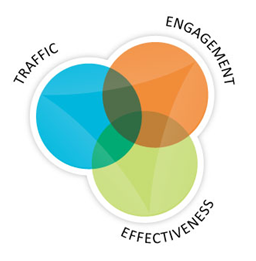Consumable & Actionable: The Missing Links to Bringing Data to Life

By Aaron Dun, Percussion Software
Marketers are drowning in web data. Even worse, that data isn't presented in a way that lets us actually use it to make decisions about our overall web effectiveness. Instead, we continue to rely on the same static "rear-view-mirror" charts.
But to really do web and content marketing right, it's time to get serious about putting data to work. -- Most importantly, making that data consumable (presented in a format that can be easily understood) and actionable (letting a marketer take action directly from the point of analysis).
To achieve both these missing links, we need to first dig into the rise of the effectiveness measure.
The Rise of Effectiveness Analytics
The focus of web marketing has shifted to transparent conversations between customers and vendors across the entire digital spectrum. No longer relegated to the "back corner of the web," these conversations are taking place on a company's websites, in their blogs, in their communities, and in their direct and indirect social channels. And those conversations are happening both vendor-to-customer and customer-to-customer.
As a result of this conversation overload and the rising content marketing trend, marketers are dutifully churning out pages, blog posts, articles, videos and whatever else they believe will interest their targets. But if they have no idea which of those content pieces are the most engaging, and which ones are falling flat, even the most creative marketers will fail to deliver.
The widening gap between web analytics and web effectiveness doesn't make the task of measuring success any easier. Tools like Google Analytics or Omniture's Webtrends will show you how a web site's traffic is performing. Radian6 and similar tools will help you assess how well your company's voice is being amplified in the market. But evaluating performance on the basis of these measures alone won't allow a marketer to optimize for success.
Static traffic analysis, for example, will not explain why a particular page or piece of content is not driving the expected engagement or interaction. Is it the content? Is it the audience it was aimed at? Or, the location on the site or the community to which it was posted? Is the page not being extended to crucial social channels? These are the content effectiveness measures that tell the true story of what's working, and what's not.
From Effectiveness to Action
Even when the trends presented in the traffic, engagement and effectiveness analysis are clear, the information presented in these tools must be actionable, enabling a marketer to make changes directly from the point of analysis. Without this ability to take action, the recommended next step gets relegated to somebody's long list of web marketing to-do's.  In short, marketers must dive a layer deeper. They need to understand how they can leverage all the data-from site traffic, to SEO data, to social commentary and trending, all the way to inbound links and content performance-to truly put effective web and content marketing strategies in place.
In short, marketers must dive a layer deeper. They need to understand how they can leverage all the data-from site traffic, to SEO data, to social commentary and trending, all the way to inbound links and content performance-to truly put effective web and content marketing strategies in place.
To make sense of the mountain of data, consider the following Venn diagram. One circle is traffic analytics, another is engagement and conversation analytics, and the third is content effectiveness. A well-structured content management strategy supported by a next generation web content and web experience system sits at the intersection of these three circles. There, it provides companies a deeper analysis of what content is working, why and where content bottlenecks are emerging.
Bringing together this data spotlights which pieces of content you should be sharing and in what channels, which template styles aren't performing optimally because visitors may be getting lost, what content themes are creating the most engagement, etc. Further, the web content management system provides the instant "actionability" to make that change then and there.
Now, marketers can read and react, rather than read and report-a critical missing link in helping drive effective content marketing initiatives on the web.
Here's how. With a full understanding that spikes in traffic were due to a specific article or blog posting, a marketer can make instant adjustments directly from the analytics. These adjustments may be to draw additional traffic to the topic through content tagging that pushes the content further into the community, or launching new campaigns using that content, add additional calls to action on the spiking pages, or accelerate additional content on the topic. Because the analysis is actionable, the marketer can effectively make these changes in real-time.
From Action to Value
The business world is moving too quickly for organizations to rely solely on static analytics or "best guesses" about what's driving customer engagement. With an effective web content strategy and supporting systems in place, marketers can examine data at the intersection of traffic, engagement, and content -- providing valuable insight into their web marketing activities. By going one step further, and making this new found intelligence actionable, marketers can move from analytics to action at "web speed."
After all, speed matters. The quicker you are to spot trends and act on them, the more value you, as marketers, can deliver to the business.
About the Author: Aaron Dun is Vice President of Marketing and Strategy for Percussion Software, a leading provider of Web Content Management (WCM) software.








